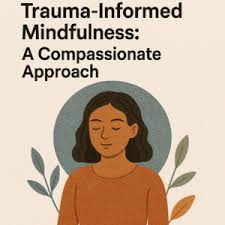Experiencing trauma can change you in ways, sometimes unfathomable and always difficult to understand. We have been introduced to several mindful practices to help keep us going but if you have tried traditional mindfulness and felt overwhelmed, you’re not alone. For some people who have experienced trauma, standard meditation practices – like focusing on breath or sitting still or counting – can sometimes trigger discomfort or even flashbacks. Thats where Trauma Informed Mindfulness comes in.
This is a compassionate, adaptive and tailored to your need approach gaining popularity in 2025 as a safe way to support mental health and healing. Curious to know what exactly it is? Lets find out!
Understanding Trauma Informed Mindfulness
Trauma informed mindfulness is a tailored form of mindfulness designed with trauma survivors in mind. Unlike conventional meditation, which might push you to “clear you mind,” this practice prioritizes safety, choice, and empowerment. It recognises that its not one size fits all.
It is designed to avoid retraumatization, making it ideal for survivors of PTSD, anxiety, or other trauma related conditions. It is grounded in an understanding of how trauma affects the mind and body, often leaving the nervous system on high alert or prone to dissociation. By adapting techniques, it offers a gentler path to present moment awareness.
So, why is it trending? As awareness of trauma’s lasting impact grows—thanks to books like The Body Keeps the Score and discussions around post-pandemic stress—people are searching for mindfulness for trauma that feels accessible and healing.
Core Principles of Trauma-Sensitive Meditation
– Safety First: Practitioners are encouraged to feel secure, whether that means keeping eyes open or choosing a comfortable posture.
– Choice and Control: You decide how to engage—pause, adjust, or stop anytime. This restores agency often lost in traumatic experiences.
– Gentle Body Awareness: Instead of diving deep into sensations that might trigger distress, you start with neutral areas like your hands or feet.
– No Pressure: There’s no “right” way to feel. The focus is on acceptance, not forcing emotions away.
– Flexible Focus: If the present moment feels too intense, you’re free to shift attention elsewhere—no judgment.
These principles make trauma-sensitive meditation a powerful tool for rebuilding trust in your body and mind.
How Does Trauma-Informed Mindfulness Work?
Traditional mindfulness might ask you to sit quietly and observe your breath—a challenge if that triggers panic. Trauma-informed practices offer alternatives:
– Grounding Techniques: “Feel your feet on the floor—notice that if it’s okay,” a facilitator might say. It’s simple but effective.
– Somatic Check-Ins: Scan your body for tension without needing to change it, fostering awareness at your own pace.
– Titration: Focus on sensations in small doses—like a few seconds of breath awareness—before shifting to something neutral.
– Safe Space Visualization: Picture a comforting place to retreat to if emotions get heavy.
– Movement: Rock, stretch, or walk to stay regulated, unlike static meditation.
These methods ensure Mindfulness for PTSD or anxiety doesn’t overwhelm but supports.
Benefits of Trauma-Informed Mindfulness
Why try it? Research shows it can:
– Reduce PTSD, anxiety, and depression symptoms.
– Help you feel safe in your body again.
– Improve emotional regulation through a mind-body connection.
– Build resilience without forcing you to relive trauma.
Why It’s Trending Now
Searches for “trauma-informed mindfulness” and “trauma-sensitive meditation” are spiking as people recognize trauma’s widespread impact—whether from personal experiences, climate anxiety, or societal shifts. Therapists and wellness apps are integrating it with *somatic therapy* and polyvagal theory, which explains how our nervous system reacts to safety and threat. It’s a natural fit for today’s holistic wellness movement.
How to Start Practicing Trauma-Informed Mindfulness
Ready to try it? Here’s a quick exercise:
1. Sit or stand in a way that feels stable.
2. Notice your feet or hands—focus on that sensation for a few seconds.
3. If your mind wanders or you feel uneasy, shift to a sound or object nearby.
4. Stop whenever you need to—no rules.
For more, explore resources like the Trauma Resource Institute or books by experts like Bessel van der Kolk.
Trauma-informed mindfulness isn’t just a buzzword—it’s a lifeline for those navigating trauma’s aftermath. By blending safety with awareness, it offers a path to healing that’s as unique as you are. Have you tried it? Share your thoughts in the comments below!






